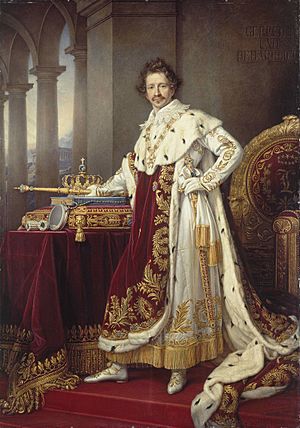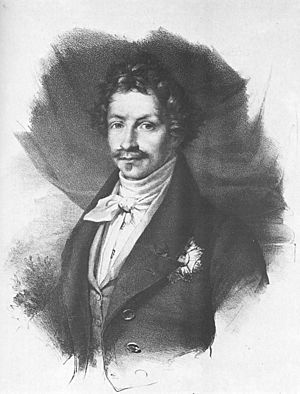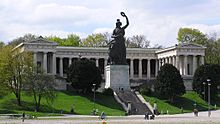Ludwig I of Bavaria facts for kids
Quick facts for kids Ludwig I |
|||||
|---|---|---|---|---|---|

Portrait by Joseph Stieler, 1825
|
|||||
| King of Bavaria | |||||
| Reign | 13 October 1825 – 20 March 1848 | ||||
| Predecessor | Maximilian I Joseph | ||||
| Successor | Maximilian II | ||||
| Born | 25 August 1786 Strasbourg, Kingdom of France |
||||
| Died | 29 February 1868 (aged 81) Nice, Second French Empire |
||||
| Burial | St. Boniface's Abbey, Munich | ||||
| Spouse | Therese of Saxe-Hildburghausen | ||||
| Issue | Maximilian II of Bavaria Mathilde Caroline, Grand Duchess of Hesse and by Rhine Otto I of Greece Princess Theodelinde Luitpold, Prince Regent of Bavaria Adelgunde, Duchess of Modena Archduchess Hildegard of Austria Princess Alexandra Prince Adalbert |
||||
|
|||||
| House | Wittelsbach | ||||
| Father | Maximilian I Joseph of Bavaria | ||||
| Mother | Princess Augusta Wilhelmine of Hesse-Darmstadt | ||||
| Religion | Roman Catholicism | ||||
| Signature |  |
||||
Ludwig I (born August 25, 1786, died February 29, 1868) was the King of Bavaria from 1825 until 1848. He was known for his love of art and for making Munich a center of culture. He also faced political challenges and eventually gave up his throne during the revolutions of 1848.
Contents
Early Life and Education of Crown Prince Ludwig
Ludwig was born in Strasbourg, France. His father was Maximilian I Joseph of Bavaria, who later became the first King of Bavaria. Ludwig's mother was Princess Augusta Wilhelmine of Hesse-Darmstadt. He was named after Louis XVI of France, who was his godfather.
Family Background and Royal Titles
In 1795, Ludwig's father became the Duke of Zweibrücken. A few years later, in 1799, his father became the Elector of Bavaria. This meant he gained more power and land. In 1806, Ludwig's father took on the title of King of Bavaria. This made Ludwig the Crown Prince.
Studies and Marriage
Ludwig studied at universities in Landshut and Göttingen starting in 1803. He learned from important teachers like Johann Michael Sailer. On October 12, 1810, he married Therese of Saxe-Hildburghausen. Their wedding celebration was the very first Oktoberfest, a famous festival still held today.
Military Service and Political Views
Ludwig did not like his father's alliance with Napoleon I of France. Despite this, he had to join Napoleon's wars with Bavarian troops in 1806. He commanded a division in 1809 and fought in the Battle of Abensberg.
In 1813, Bavaria left Napoleon's side and joined the fight against him. This was called the Sixth Coalition. Crown Prince Ludwig strongly supported this decision. He believed in a united German policy, even at the Congress of Vienna in 1815.
Governor and Supporter of Greece
From 1815 to 1816, Ludwig served as governor of the Duchy of Salzburg. He did not want Salzburg to be given to Austria. His second son, Otto, who later became King of Greece, was born there.
Ludwig spent many years traveling, especially in Italy. He was a Philhellene, meaning he loved Greek culture. He strongly supported the Greek War of Independence. He even gave a large loan from his own money to help the Greeks fight for their freedom in 1821.
Becoming King of Bavaria
Ludwig also played a part in the removal of Prime Minister Maximilian von Montgelas in 1817. Ludwig disagreed with Montgelas's policies. In 1825, Ludwig became King of Bavaria after his father passed away.
King Ludwig I's Reign (1825-1848)
King Ludwig I's time as ruler was marked by his great love for the arts and his strong belief in royal power.
Cultural Achievements and Building Projects
Ludwig was a big fan of the German Middle Ages. He ordered many monasteries in Bavaria to be reopened after they had been closed. He also changed the names of Bavaria's administrative regions in 1837. He brought back old names like Upper Bavaria, Lower Bavaria, Franconia, Swabia, and Upper Palatinate. He changed his royal title to include these areas.
Ludwig wanted to reunite the eastern part of the Palatinate region with Bavaria. This area had been taken by France and then given to Baden during Napoleon's time. Ludwig founded the city of Ludwigshafen am Rhein as a Bavarian city to rival Mannheim.
He moved the Ludwig-Maximilians-Universität from Landshut to Munich in 1826. He also encouraged new industries in Bavaria. He started the Ludwig Canal to connect the Main and Danube rivers. In 1835, the first German railway was built in his kingdom, connecting Fürth and Nuremberg. Bavaria also joined the Zollverein, a customs union, in 1834.
Supporting Greece and Otto's Rule
Because Ludwig had supported Greek independence, his second son, Otto, was chosen to be the first King of Greece in 1832. Otto's government was first run by Bavarian officials.
Political Challenges and Censorship
After the July Revolution in France in 1830, Ludwig's policies became stricter. The Hambacher Fest in 1832 showed that people were unhappy with high taxes and censorship. Many political trials took place, and some people were sentenced to long prison terms.
Ludwig brought back strict censorship, which he had removed earlier. This was unpopular with many people.
Religious Tensions and Abdication
In 1837, a group called the Ultramontanes, supported by the Roman Catholic Church, gained power in the Bavarian parliament. They tried to change the constitution, taking away civil rights from Protestants and increasing censorship. Ludwig also ordered soldiers to kneel during Catholic church services.
This policy caused problems, especially since Bavaria now had many Protestant areas. A scandal happened in 1841 during the funeral of the Protestant Queen Caroline of Baden. This event made Ludwig, who had been against Protestantism, soften his views.
The Ultramontanes lost power when they opposed Ludwig's decision to allow his Irish-born friend, Lola Montez, to become a Bavarian citizen. Ludwig was upset by their opposition and removed them from power.
In 1844, Ludwig faced the Beer riots in Bavaria. Then, during the revolutions of 1848, students and middle-class citizens protested more and more. The king closed the university in February. On March 4, a large crowd attacked the Armory and tried to storm the Munich Residenz, the royal palace.
Ludwig's brother, Prince Karl, calmed the protesters. But the royal family and the government turned against Ludwig. He had to sign the "March Proclamation," which gave many concessions to the people. More unrest followed on March 16, 1848, when Lola Montez returned to Munich. Ludwig was forced to have her searched by police, which was a great humiliation for him.
Not wanting to rule as a constitutional monarch (where the king's power is limited by a constitution), Ludwig gave up his throne on March 20, 1848. His eldest son, Maximilian, became the new king.
Life After Abdication
Ludwig lived for another twenty years after giving up his throne. He remained important, especially because he continued his cultural projects. He lived in the neo-Gothic Wittelsbacher Palais in Munich. He died in Nice in 1868 and was buried in St. Boniface's Abbey, Munich, a church he had ordered to be built.
King Ludwig I's Cultural Legacy
Ludwig loved ancient Greece and the Italian Renaissance. He supported the arts and paid for many beautiful buildings, especially in Munich. He was also a passionate collector of art.
Famous Buildings and Art Collections
Some of the famous buildings he had constructed include the Walhalla temple, the Befreiungshalle, the Villa Ludwigshöhe, the Pompejanum, the Ludwigstrasse, the Bavaria statue, the Ruhmeshalle, the Glyptothek, the Old Pinakothek, and the New Pinakothek. His architects, Leo von Klenze and Friedrich von Gärtner, also helped shape the city of Athens.
Even as a crown prince, Ludwig collected many artworks. He collected early German and Dutch paintings, Italian Renaissance masterpieces, and modern art for his museums. He especially loved Greek and Roman sculptures. He acquired famous pieces like the Medusa Rondanini and the Barberini Faun.
One of his most famous ideas was the "Gallery of Beauties" (Schönheitengalerie). This is a collection of 36 portraits of beautiful women painted between 1827 and 1850, mostly by Joseph Karl Stieler. These portraits are displayed in his Nymphenburg Palace in Munich.
Continued Support for the Arts
Even after he gave up his throne, Ludwig continued to be a major supporter of the arts. He spent his own money on these projects, which sometimes caused disagreements with his son, King Maximilian II.
Impact on Bavarian Language
Because King Ludwig loved Greek culture (philhellenism), the German name for Bavaria today is spelled "Bayern" (with a 'y' from Greek). However, the language spoken there is still spelled "Bairisch" (with an 'i').
Poetry and Humor
Ludwig was known for being a bit eccentric and for writing poetry, even about small things. He would write in rhyming couplets. The famous writer Heinrich Heine even made fun of Ludwig's poetry style. However, in an ironic twist, Heine's own bust was added to Ludwig's Walhalla temple in 2009.
King Ludwig I's Family Life
Ludwig was modest and friendly in his private life, even though he was a king. He was known for his simple clothes. He was hard of hearing and had a birthmark on his forehead that was often hidden in his portraits.
Children of King Ludwig I
Ludwig and his wife, Therese of Saxe-Hildburghausen, had several children:
- Maximilian Joseph (1811–1864): He became the next King of Bavaria.
- Mathilde Karoline (1813–1862): She married Ludwig III, Grand Duke of Hesse and by Rhine.
- Otto Friedrich Ludwig (1815–1867): He became the first King of Greece.
- Theodolinde Charlotte Luise (1816–1817): She died as a baby.
- Luitpold Karl Joseph Wilhelm Ludwig (1821–1912): He later became the Regent of Bavaria.
- Adelgunde Auguste Charlotte Caroline Elisabeth Amalie Marie Sophie Luise (1823–1914): She married Francis V, Duke of Modena.
- Hildegard Luise Charlotte Theresia Friederike (1825–1864): She married Archduke Albert, Duke of Teschen.
- Alexandra Amelie (1826–1875): She never married.
- Adalbert Wilhelm Georg Ludwig (1828–1875): He married Infanta Amelia Philippina of Spain.
Images for kids
-
Crown Prince Ludwig, 1807 by Angelica Kauffman
See also
 In Spanish: Luis I de Baviera para niños
In Spanish: Luis I de Baviera para niños







